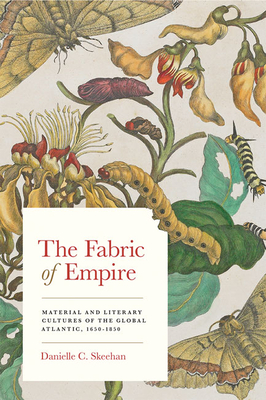

 Johns Hopkins University Press
Johns Hopkins University Press
The Fabric of Empire: Material and Literary Cultures of the Global Atlantic, 1650-1850


Key Metrics
- Danielle C Skeehan
- Johns Hopkins University Press
- Hardcover
- 9781421439686
- 9 X 5.9 X 0.8 inches
- 0.9 pounds
- History > United States - General
- English
 Secure Transaction
Secure TransactionBook Description
Textiles are the books that the colony was not able to burn.--Asociaci�n Femenina para el Desarrollo de Sacatep�quez (AFEDES)
A history of the book in the Americas, across deep time, would reveal the origins of a literary tradition woven rather than written. It is in what Danielle Skeehan calls material texts that a people's history and culture is preserved, in their embroidery, their needlework, and their woven cloth. In defining textiles as a form of cultural writing, The Fabric of Empire challenges long-held ideas about authorship, textuality, and the making of books.
It is impossible to separate text from textiles in the early modern Atlantic: novels, newspapers, broadsides, and pamphlets were printed on paper made from household rags. Yet the untethering of text from textile served a colonial agenda to define authorship as reflected in ink and paper and the pen as an instrument wielded by learned men and women. Skeehan explains that the colonial definition of the book, and what constituted writing and authorship, left colonial regimes blind to nonalphabetic forms of media that preserved cultural knowledge, history, and lived experience. This book shifts how we look at cultural objects such as books and fabric and provides a material and literary history of resistance among the globally dispossessed.
Each chapter examines the manufacture and global circulation of a particular type of cloth alongside the complex print networks that ensured the circulation of these textiles, promoted their production, petitioned for or served to curtail the rights of textile workers, facilitated the exchange of textiles for human lives, and were, in turn, printed and written on surfaces manufactured from broken-down linen and cotton fibers. Bringing together methods and materials traditionally belonging to literary studies, book history, and material culture studies, The Fabric of Empire provides a new model for thinking about the different media, languages, literacies, and textualities in the early Atlantic world.
Author Bio
My research focuses on American and transatlantic literature of the long eighteenth century. I take a broad view of what we mean when we say “American literature,” questioning both the geographic confines of the “Americas” as well as what constitutes “literary” production. For instance, the goal of my current book project, The Fabric of Early Atlantic Letters, is to think about the different media people used to communicate, tell stories, and negotiate relationships with others. Images, songs, and material artifacts—in addition to the written word—have the capacity to incorporate their makers and users into social worlds.
In my teaching I am also committed to reading literature in its transnational and global contexts, and I regularly seek to expand the traditional parameters of the literature classroom. Through visits to the archive, we consider texts in their original form and, moving beyond text, we think about how we may read a variety of early Atlantic objects and aesthetics, ranging from women's needlework and woven baskets to sea shanties and soundscapes.
Teaching interests include: Atlantic literature to 1900; gender and sexuality; material culture; book history; media studies.
Education
- BA, Boston University, 2003
- MA, Mills College, 2006
- PhD, Northeastern University, 2013
Source: Oberlin College and Conservatory
Videos


Community reviews
Write a ReviewNo Community reviews